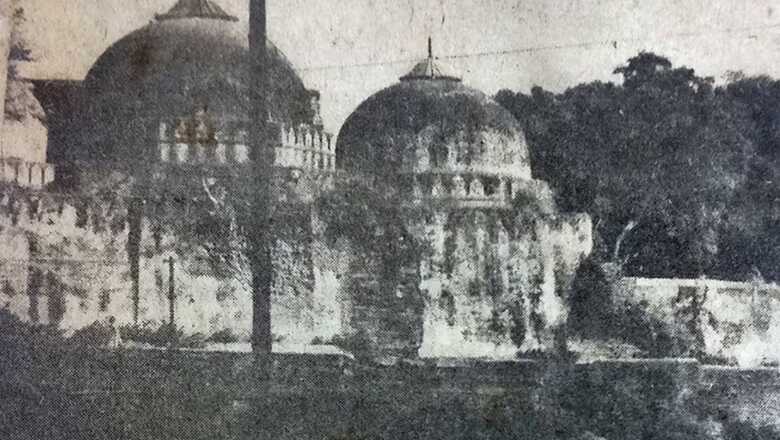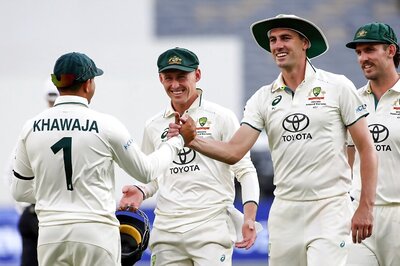
views
Two major changes happened in India’s socio-political sphere when the Babri structure was demolished on December 6, 1992. Why it is technically incorrect to refer to the razed construction as the Babri Masjid is a settled debate now, no less because the highest court of the country has given its last word on it. Whether the demolition amounted to a defiance of history — admittedly, a dark chapter in history — is not what this article is about. Evidence of temples of Before Christ vintages or citations from the Skanda Purana are no longer required. This is about how we and our polity changed since that day 31 years ago.
Society
Pre-1992, most Muslims would be at pains to establish their roots were not Indian. Some claimed they had descended from Turks; some said they were originally Arabs; some traced their roots back to Tajikistan, Uzbekistan or Kazakhstan. The rest, their obvious Indian looks notwithstanding, were hell bent on proving they were central Asians if not Mughals.
This is not an opinion. Read the biography of the venerated Urdu poet, Mirza Asadullah Khan Baig ‘Ghalib’. He demanded pension from the East India Company, citing Seljuq Turk roots, explaining painstakingly to the British how his grandfather Mirza Qoqan Baig arrived in India from Samarkand while Ahmad Shah was ruling. Ghalib’s applications to British authorities mention how his grandpa worked in Lahore, Delhi and Jaipur, was awarded the sub-district of Pahasu (in Bulandshahr, Uttar Pradesh) and finally settled in Agra, on the basis of which the poet thought he deserved a pension! Think of it, Ghalib was one of the most inclusive, tolerant, pluralistic Muslims India has ever known, and even such a person was reluctant to identify as an Indian.
That Mughals were originally Uzbeks is documented history. That Sheikhs are Arabs is well-known. That a Muslim who claims to be a Sayyad/Syed/Sayyid must be a descendant of the clan of Prophet Mohammed and cannot, therefore, be of Indian origin is something claimed by Sayyads/Syeds/Sayyids themselves. That Pathans are of the ethnic Pashtun ancestry from the landmass in Pakistan and Afghanistan that are no longer parts of India is a geographical truth.
Who are left then? If an Indian Muslim is neither a Sheikh nor a Syed nor a Mughal nor a Pathan, he must be what they call “Pasmanda”. This implies his forefathers were Hindu. If leftist sociologists and historians are to be believed, they were from the underprivileged class who converted with the belief Islam would offer them a better deal. Indeed, these days, most of them claim their ancestors were Shudras, including Kashmiri Muslims who couldn’t have been Hindu Shudras before conversion because all Kashmiris were originally Pandits (Brahmins)!
Among Hindus, in the debate leading up to the demolition, the arguments were not so much on the history of the disputed plot and the equally contentious structure named after Babar. It was more about how Hindus, the majority, had got a raw deal from the state for the 45 years preceding 1992. The corollary included how Muslims returned the favour to the nation ― rather, how they did not. That triggered the community into asserting their Indian identity. But who in the Islamic community made these mutually conflicting claims pre- and post-1992?
Leftists do not buy the “Islam spread by the might of the sword” theory while Pasmanda Muslims themselves say neither the ‘sword of Islam’ nor the ‘discrimination’ in the Hindu fold is exactly what happened. They say it was a convention in mediaeval history that if a ruler converted, his subjects followed suit. So, that is how they became Muslim — their (small-time) kings bowed to the might of the sword and the subjects did what their kings did. But barbers, weavers, cobblers, carpenters, plumbers, electricians, fitters, mechanics, peasants etc are not the Muslims who pick up an intellectual fight with you. It’s the upper class who once claimed they were Turks, Uzbeks, Afghans etc that dare, post-1992, the country to brand them as “not Indian”. That is one big change that the discourse which followed the demolition of the Babri structure brought about.
Politics
The polity was divided between pro-Congress and anti-Congress camps, witnessed most clearly in the 1989 election when even the CPI(M) and the BJP supped together with VP Singh to bring down the Rajiv Gandhi government. Once the Babri structure fell, it became for and against the BJP. Barely four years later, Atal Bihari Vajpayee saw how difficult it was to forge an alliance to attain a majority in Parliament, as his first government collapsed in 13 days.
Between then and the Supreme Court verdict, the BJP struggled with its cultural policy. The deposition of LK Advani, Murli Manohar Joshi and Uma Bharti before the court apart, the party could not distance itself from the Ram Janmabhoomi movement that it had adopted from the VHP on the one hand. On the other hand, owning up Ram was a tricky proposition for it in the pre-2014 polling campaign phase. Even after it got past the 272 mark on its own, it was wary of allies for the next election. Caught in the tug of war between desire and exigency, it soft-peddled the issue at best.
The opposition, which had softened its stand from strident anti-Hindutva of the 1990s were mocking in the next two decades: “Mandir wahin banaayenge, lekin kab banaayenge, nahin bataayenge!” (We will build the temple right there — on the then-disputed plot — but wouldn’t tell anybody when we’re going to do it). Still waiting for the right time to arrive, BJP supporters would feel awkward, unsure what would be a befitting reply.
Meanwhile, the Supreme Court said it would treat the Ayodhya dispute as a “land title” issue. It meant for Hindus that there was no point waiting for the verdict with bated breaths. From the judiciary, the matter would return to the executive (not necessarily the legislature as a law to make a temple in a so-called secular country is untenable). The executive, in turn, would need to devise ingenious ways to ensure that the coveted Ram temple came up on the plot that three sides were fighting over at the Allahabad High Court. An executive run by the BJP alone could make that happen or face another showdown like 6 December 1992.
But that is not what transpired. When the judgement of the apex court arrived, nobody saw it as the settlement of a land title dispute. Hindus saw it as a victory in a religio-cultural war against a community of invaders and marauders who followed a barbaric ideology. The BJP claimed credit immediately. No executive order was required as the highest court of the country had made the requisite order already.
Interestingly, Hindus now were far less agitated about the issue than they were 27 years before the verdict of 2019. In the late 1980s and the first two years of the next decade, it was about undoing a historic and historical wrong. Then came a phase of indifference. What has again changed over the past almost 10 years of Narendra Modi rule is that the community has turned assertive. The Ram temple, when unveiled on 22 January 2024, will be a statement of their assertion.
The process was gradual but steadfast. Vilification gave way to accommodation reluctantly. If CPI(M)’s Sitaram Yechury rehashed an old theory that the 10 avataras of Vishnu showed ancient Indian knowledge of Darwinian evolution shortly after the Babri demolition and got the article published in major dailies, tell a leftist he is an “anti-national” today, and chances are he would turn defensive rather than brazen it out as they did pre-1992. Notice that, like Muslims, communists have nearly dumped their foreign gods — Karl Marx, Vladimir Lenin, Joseph Stalin, Mao Tse Tung, Che Guevara, Fidel Castro and Ho Chi Minh. All leftist demonstrations these days hold aloft indigenous mascots while also riding piggyback on Ambedkarite and Periyarite activism. In 2016, the communists were forced to carry the Indian national flag, along with their red flags, for the first time in their rallies.
The fallen Babri was a catalyst that turned hitherto ‘foreign’ Indians into indigenous Indians. December 6, 1992, was an agitation, whereas January 22, 2024, will be a celebration. That day, a Hindu will celebrate as much making the enemies toe his line as he would rejoice the homecoming of his king and god whose sanctum the enemies had violated.
The author is a senior journalist and writer. Views expressed in the above piece are personal and solely that of the author. They do not necessarily reflect News18’s views.



















Comments
0 comment